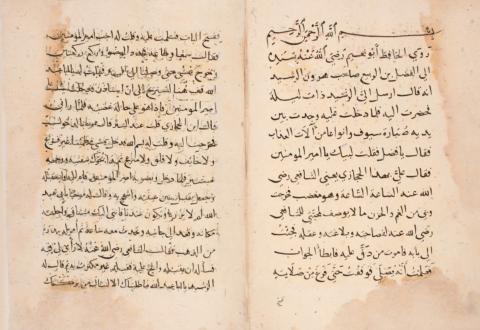Noble prayer said when standing before kings, known by experience to be beneficial (God most high willing) | دعاء شريف يقال عند مقابلة الملوك نافع مجرب إن شاء الله تعالى
Introduction to the Text
This text is attributed to Abū Nuʻaym al-Iṣbahānī (948-1038), and indeed a shorter version of the story can be found in Abū Nuʻaym’s biographical dictionary Ḥilyat al-awliyāʼ wa-ṭabaqāt al-aṣfiyāʼ (vol. 9, pp. 78-79 in the Beirut edition), which compiles biographical accounts of many early Islamic figures. This excerpt comes from the section on the foundational early legal scholar Muḥammad al-Shāfiʻī (d. 820), its central character, but has been substantially expanded and modified from Abū Nuʻaym’s original version, itself passed down from generations of earlier narrators. Abū Nuʻaym provides full chains of transmission (X said that Y said…) to authenticate each story, although in this version, the initial chain has been abbreviated on the assumption that the reader can seek out Abū Nuʻaym’s text for more complete information.
The accounts in Ḥilyat al-awliyāʼ emphasize the sanctity of early Muslims, and this one is no exception. The story is placed in the mouth of al-Faḍl ibn al-Rabīʻ (755-824), one of the most important court officials under the ʻAbbāsid caliph Hārūn al-Rashīd (r. 786-809). As al-Faḍl tells the story, he was summoned before the angry caliph one night and asked to produce al-Shāfiʻī for likely torture and/or execution. The reason for the caliph’s anger is not stated, but there is a historical nucleus to this event, for al-Shāfiʻī was nearly executed in 803, while he was governor of the rebellious city of Najrān. Different explanations have been given for the scholar’s narrow escape, including this account, which attributes his salvation to his pious recitation of a prayer at court. Through another, more complete chain of transmission, al-Shāfiʻī tells al-Faḍl that this prayer was recited by the Prophet Muḥammad during the Battle of the Trench (626-627) and contributed to the Muslims’ victory. Note that this connection to the Prophet is not found in Ḥilyat al-awliyāʼ, where the prayer is simply attributed to al-Shāfiʻī, but the expanded version amplifies its prestige. This text reflects the precarious, yet often luxurious, life of a powerful court official: you may be summoned before the caliph for torture, or you may instead receive more gold than you could ever need. One strategy for dealing with this precarity, as seen here, is to rely on the protection of God and recite this prayer each time the ruler calls your name.
As you read the text, note some of the distinctive features of classical Islamic texts, including:
-
The chain of transmission (isnād), already discussed, that provides authority for stories and sayings attributed to earlier figures. This text includes one incomplete chain and one complete chain.
-
Formulas of respect placed after the names of important people, such as “God’s peace and blessings be upon him” after a mention of the Prophet Muḥammad or “God be pleased with him” after a mention of al-Shāfiʻī.
-
Polite forms of address: the caliph is usually addressed as “Commander of the Faithful” (Amīr al-muʼminīn), while others are often called by names derived from their firstborn sons—for example, al-Shāfiʻī is often addressed as “Abū ʻAbd Allāh,” that is, “Father of ʻAbd Allāh.”
Introduction to the Source
This version of the prayer story is found only in Khalidi Library (Jerusalem) MS 214, fol. 59r-61v. The manuscript is not dated, but was likely copied around the 15th century. The elaborately decorated title page (the style may indicate that it was produced in Egypt) describes the manuscript’s contents as “a compilation that contains aphorisms and testaments and fables by Luqmān the Sage.” The texts are a miscellany of popular philosophy, including the “Testament of Pythagoras” and the “Testament of Luqmān,” in which ancient philosophers allegedly give final instructions to their disciples before their deaths. The “Fables of Luqmān,” highly similar to those of Aesop, are also included. Various other sayings attributed to ancient philosophers appear between these larger texts, along with the inscriptions that were supposedly found on the philosophers’ seals. The story of al-Shāfiʻī and his prayer is the final item in the manuscript.
At first glance, the story of the prayer is an outlier in this compilation of texts attributed to ancient philosophers, focusing on specifically Islamic characters and themes as none of the other texts do. However, we may view the entire manuscript as a collection of short texts that would be interesting and beneficial for a court official to know, collected by just such an official (perhaps in Mamlūk Egypt) with money to spend on an ornate manuscript. Pithy sayings attributed to ancient sages and entertaining animal fables with succinct moral lessons would not only be edifying for the manuscript’s owner personally, but could be useful bits of knowledge as the owner aimed to impress superiors with erudite conversation topics. This prayer (and its enjoyable frame story) fits perfectly in that court context, and so we might view this manuscript as an anthology in the tradition of adab (“etiquette”) literature, training its reader in the proper knowledge and protocols for a refined member of the upper class. The context of Khalidi MS 214 thus recasts the text to make it less about the personal sanctity of al-Shāfiʻī, as in Ḥilyat al-awliyāʼ, and more about the elite readers who might rely on this prayer for protection in a precarious world.
About this Edition
I have transcribed and translated the text from Khalidi MS 214, its only known copy in this form. I have generally maintained the spelling of the manuscript, including frequent omission of the Arabic letter hamzah (ء) that marks the glottal stop, but have standardized the dots on several letters that sometimes appear without them. The manuscript includes a surprising number of short vowel and case markings, but these have been omitted in transcription. There are few punctuation marks in the text, as with most pre-modern Arabic texts, and I have added a few additional periods to help organize the sentences. I have retained masculine language for God to reflect the usage of the Arabic text.
Further Reading
Ali, Kecia. Imam Shafi'i: Scholar and Saint. Oneworld Academic, 2011.
- Short biography of al-Shāfiʻī, the main character of this text.
Gutas, Dimitri. Greek Philosophers in the Arabic Tradition. Routledge, 2016.
- Collected essays showing some of the ways ancient philosophers were known and used in Arabic.
Kadi, Wadad. “The Humanities through Islamic Eyes: The Beginnings.” Knowledge and Education in Classical Islam: Religious Learning between Continuity and Change, edited by Sebastian Günther, vol. 1. Brill, 2020, pp. 43-58.
- Overview of some important genres of classical Islamic scholarship, including the biographical dictionary.
Mojaddedi, Jawid A. The Biographical Tradition in Sufism: The Ṭabaqāt Genre from al-Sulamī to Jāmī. Curzon Press, 2001.
- Discussion of Ḥilyat al-awliyāʼ (especially in chapter 2) and other important Sufi biographical dictionaries.
Orfali, Bilal. “The Art of Anthology in Premodern Arabic Literature.” The Anthologist’s Art: Abū Manṣūr al-Thaʻ'ālibī and His Yatīmat al-dahr. Brill, 2016, pp. 1-33.
- Study of classical adab anthologies that may provide some inspiration for the collection of short texts in this manuscript.
Credits
Transcription by Joshua MuglerTranslation by Joshua MuglerEncoded in TEI P5 XML by Danny SmithSuggested citation: Abū Nuʻaym al-Iṣbahānī [att.]. " Noble prayer said when standing before kings, known by experience to be beneficial (God most high willing)." Trans. Joshua Mugler. Global Medieval Sourcebook. http://sourcebook.stanford.edu/text/noble-prayer-said-when-standing-king.... Retrieved on April 18, 2024.

